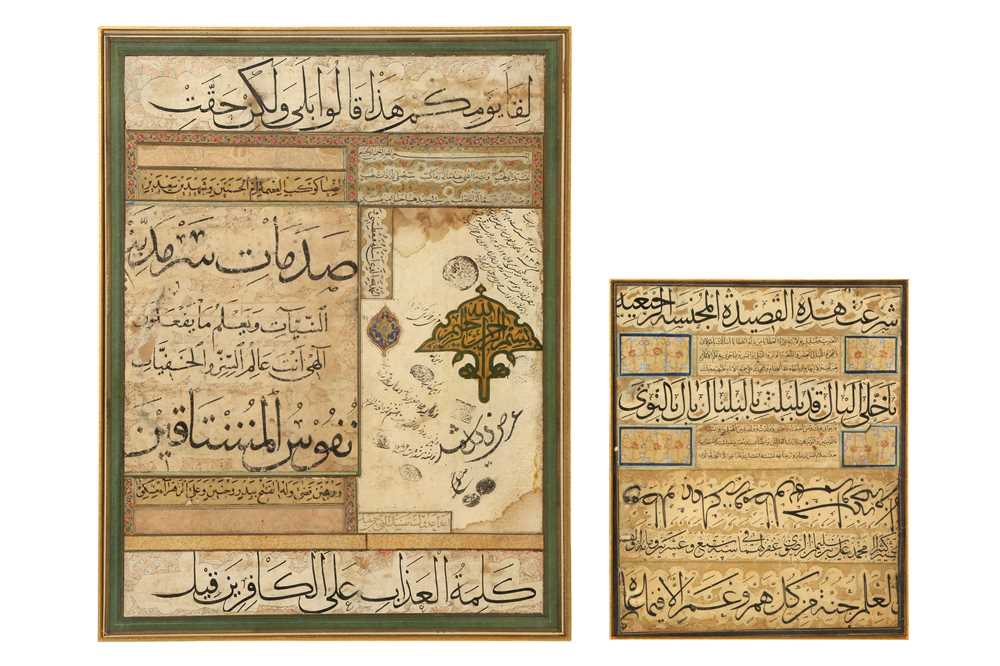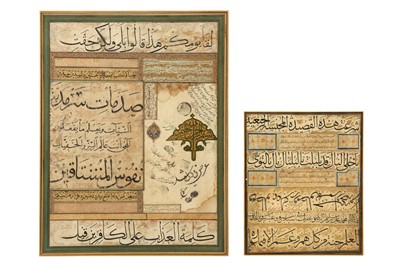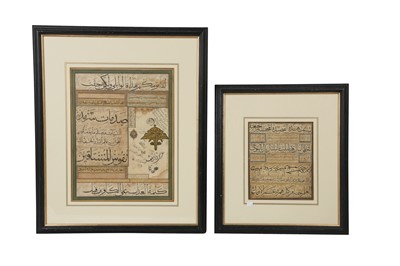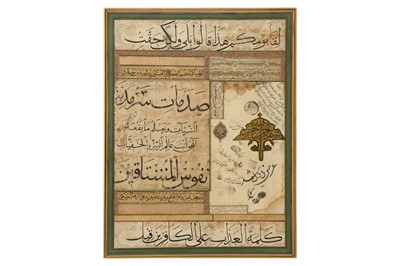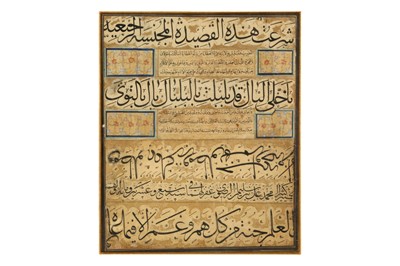28th Oct, 2022 11:00
Islamic Art - Property of a European Collector Part IV
TWO COMPOSITE MURAQQA' ALBUM CALLIGRAPHIC PANELS WITH THE 'SIX SCRIPTS'
Iran, the calligraphy 15th century and later, the album panels 19th century
TWO COMPOSITE MURAQQA' ALBUM CALLIGRAPHIC PANELS WITH THE 'SIX SCRIPTS'
Iran, the calligraphy 15th century and later, the album panels 19th century
Arabic and Persian manuscripts on cut-and-paste assembled paper, illustrating several examples of the ‘six scripts’ in varying scales, featuring Quranic verses, Arabic prayers and qasida, and illumination, painted in opaque pigments, black ink, and gold, comprising a panel signed Mohammad (Ali Bin?) Suleyman Al-Razavi, dated 1129 AH (1717), within black rules, mounted, framed and glazed, 23cm x 18.6cm, 45.5cm x 40.5m including the frame; and another panel with a bismillah in green and gold in a stylised escutcheon-shaped cartouche, marginal notes in informal shikasteh nasta’liq script in Persian on the opening page of a Kitab al-Shifa (the Book of Healing), dated 28 Zil Haj 1296 AH (1879), and a death record dated 22 Safar 1233 AH (1817), various library stamps, within green band and gold rules, mounted, framed and glazed, 37.3cm x 27.2cm, 62.8cm x 51.5cm including the frame.
Calligraphic muraqqa' albums, by definition, contain specimens of different scripts from various sources. They maintained popularity among enthusiasts from the 16th century onwards, outlasting many other collecting trends. The noteworthy point in the present examples is the span of age they encompass - from their creation in the 15th and 16th centuries to the time the albums were assembled in Qajar times, possibly around the late 19th century. Among collectors, there was less concern with cohesion and chronology than variety and quality. The current lot exemplifies these fine fragments, enhanced by the balanced mise en page. Regardless of the size and content, good calligraphy was never discarded and undervalued: it was embellished and edged in gold. Each calligraphic line or panel is a reminder of the glorious book it was once part of.
The ‘six scripts’, also known as the Six Pens, refer to the six proportional scripts of Arabic calligraphy: muhaqqaq, rayhani, thuluth, naskh, riqa’, and tawqi’. In Iran, on top of these, there were two more scripts: nasta'liq and shekasteh nasta'liq. The muraqqa' format permitted a hybrid co-mingling of styles in a manner that a single book never would: the visual fusion encouraged stimulus and discourse, feeding the encyclopedic passion of collectors and calligraphy connoisseurs.
Sold for £8,750
Includes Buyer's Premium
Do you have an item similar to the item above? If so please click the link below to submit a free online valuation request through our website.
